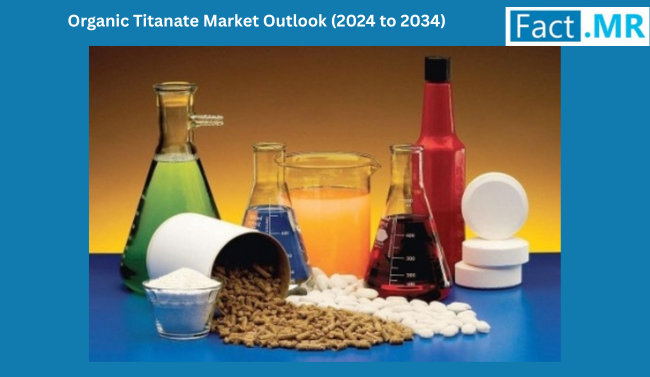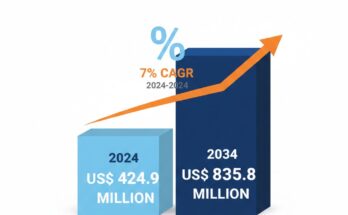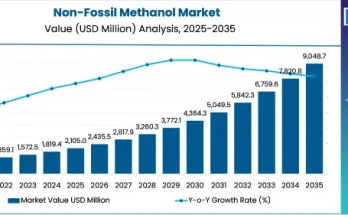This in-depth document meticulously analyzes the market trends and forecasts, providing valuable insights for stakeholders. With a focus on the period from 2024 to 2034, it offers a comprehensive outlook essential for strategic decision-making in the evolving landscape of organic titanates. Exploring the period from 2024 to 2034, the document delves into crucial insights necessary for strategic decision-making within the dynamic realm of organic titanates. An upsurge in the organic titanate market is evident, propelled by the rising needs across diverse sectors.
Organic titanates, valued for their multifaceted roles as coupling agents, dispersants, and crosslinkers, are increasingly prominent in the automotive, construction, electronics, and coatings industries. The surge in demand underscores the importance of sustainable advancements and efficient material solutions to meet the evolving requirements of end-use sectors. The escalating demand for organic titanates highlights the critical role they play in delivering performance enhancements while supporting industry-wide shifts toward eco-friendly practices.
The organic titanate market is experiencing substantial growth, driven by its rising utilization across a wide range of sectors. Known for their versatility, organic titanates continue to gain momentum due to their effectiveness in enhancing material performance and durability. As industries increasingly adopt environmentally friendly and efficient materials, the demand for organic titanates will continue to grow, emphasizing the need for sustainable innovations and high-performance solutions that meet changing industrial demands.
The global organic titanate market is projected to grow from a valuation of US$ 891.8 million in 2024 to US$ 1,770.8 million by 2034, registering a strong compound annual growth rate (CAGR) of 7.1%.
Market Overview:
Organic titanates are chemical materials that are generally composed of a titanium atom linked to organic groups, providing better properties like improved adhesion, enhanced dispersibility, and increased chemical stability. Organic Titanates possess these characteristics, which make them a desirable material for applications where accurate performance under different conditions is needed. Their major applications in industrial processes involve serving as coupling agents in polymer systems, enhancing interbonding between organic polymers and inorganic materials, and enhancing the performance of rubber, plastics, and coatings.
The growth of the organic titanate market can be attributed to the versatility of the applications in numerous industries. Within the automotive sector, Organic Titanates are being used in coating systems to enhance adhesion and durability. Within construction, Organic Titanates are being used within cement and concrete mixtures to provide water resistance and longer lifetimes. Additionally, the electronics industry is taking up Organic Titanates for creating high-performance circuit boards and semiconductors.
The global market is being driven by an increasing focus on eco-friendly and sustainable products. Organic Titanates provide a bespoke solution for industries that wish to uphold high standards of quality while conforming to tight environmental compliance. Their ability to optimize the characteristics of various materials with minimal environmental footprint is turning them into an increasingly popular option for manufacturers in most sectors.
Market Dynamics and Drivers:
The organic titanate market’s growth is not only supported by technological advancements but also by broader macroeconomic factors that are shaping various industries globally. These factors include growing demand for high-quality materials, sustainability pressures, and stringent environmental regulations.
Environmental Regulations and Sustainability Pressures: As industries face increasing scrutiny over their environmental impact, there is a heightened focus on adopting greener technologies and materials. Organic Titanates, often regarded as environmentally friendly compared to traditional chemical alternatives, play an essential role in this transition. Their ability to improve the properties of various materials while reducing the overall environmental footprint is driving their adoption. For instance, Organic Titanates can be used in construction materials to enhance durability, thereby reducing the frequency of replacements and reducing waste. Similarly, in the automotive sector, their use in coatings improves the longevity of vehicles, reducing the need for repairs and refinishing, which in turn minimizes the overall environmental impact.
Growing Demand for High-Performance Materials: Industries are increasingly focused on the need for high-performance materials that can withstand extreme conditions, offer better functionality, and maintain durability over longer periods. Organic Titanates, with their excellent bonding capabilities, ability to enhance adhesion, and improve water and corrosion resistance, meet these high-performance standards. As sectors such as automotive, electronics, and construction continue to push for better material performance, the demand for Organic Titanates will likely continue to rise. The ability to function under extreme heat, moisture, or pressure, while maintaining long-term stability, makes Organic Titanates invaluable in these industries.
Growth of Industrial Manufacturing and Infrastructure Projects: As developing economies experience rapid urbanization, the demand for industrial manufacturing and infrastructure development continues to grow. This increased demand for construction, automotive, and electronics applications creates a favorable environment for the Organic titanate market. Infrastructure projects require highly durable materials, often in challenging environmental conditions, which in turn drives the need for advanced materials such as Organic Titanates. The rise in construction projects, particularly in emerging markets, will be a major contributing factor to the market’s continued growth.
Demand from Emerging Markets: Emerging markets, especially in Asia-Pacific and Latin America, represent a substantial growth opportunity for Organic Titanates. Countries like China and India are undergoing rapid industrialization, particularly in the automotive and construction sectors, which are some of the key consumers of Organic Titanates. As these economies grow, there is a corresponding demand for durable, high-performance materials, driving the adoption of Organic Titanates. Additionally, these markets are increasingly embracing sustainable development practices, pushing for more eco-friendly alternatives that organic titanates can provide.
Regional Insights:
- North America: North America is one of the dominant regions in the Organic titanate market, driven by strong demand from industries such as automotive, construction, and electronics. The region’s advanced technological infrastructure and significant investments in R&D contribute to the market’s growth. Moreover, North America’s increasing focus on environmentally friendly and sustainable solutions further boosts the demand for Organic Titanates. Countries like the United States and Canada are particularly at the forefront of adopting cutting-edge technologies in various industrial applications.
- Europe: Europe follows closely behind in terms of market growth. The European Union’s stringent regulations concerning environmental protection and sustainability have spurred demand for eco-friendly alternatives in the chemical industry. Organic Titanates are gaining traction in Europe, particularly in coatings and construction applications. The automotive sector, with a strong presence of manufacturers focused on high-performance and environmentally conscious vehicles, also contributes significantly to the market’s expansion.
- Asia-Pacific: The Asia-Pacific (APAC) region is emerging as a critical market for Organic Titanates due to the rapid industrialization and increasing manufacturing activities in countries like China, Japan, and India. The growing automotive, construction, and electronics industries are pivotal in driving market demand. The region’s adoption of organic titanates is also attributed to the rising focus on enhancing the durability and performance of materials used in industrial applications.
- Rest of the World: The rest of the world, including regions such as the Middle East and Africa, is experiencing gradual growth in the Organic titanate market. In these regions, the demand is primarily driven by construction and automotive industries. These regions are also witnessing a surge in demand for environmentally friendly and high-performance materials, further contributing to the market’s growth.
Applications & End-Use Outlook:
- Automotive Industry: The automotive industry is one of the largest consumers of Organic Titanates. These compounds are widely used in coating systems to improve adhesion and durability. As the automotive industry shifts toward more eco-friendly materials and manufacturing processes, Organic Titanates are gaining popularity for their ability to improve the performance of paints and coatings, offering better corrosion resistance and longer-lasting finishes.
- Construction Industry: Organic Titanates are increasingly being utilized in the construction industry, particularly in the formulation of high-performance cement and concrete products. These titanates enhance the water resistance and durability of construction materials, making them ideal for use in harsh environmental conditions. As the demand for longer-lasting and environmentally friendly building materials grows, the construction industry’s reliance on Organic Titanates is expected to increase.
- Electronics Industry: The electronics industry, particularly in the production of high-performance circuit boards and semiconductors, is another key end-user of Organic Titanates. These compounds improve the dispersion of materials, enhance adhesion between layers, and increase the longevity of electronic components. As the demand for miniaturized and high-performance electronics rises, the need for organic titanates in this sector will continue to grow.
- Coatings & Paints Industry: Organic Titanates are widely used as coupling agents and dispersants in the formulation of coatings and paints. They improve the adhesion of coatings to various substrates, ensuring longer-lasting finishes with improved resistance to wear and tear. The growing demand for high-quality, durable paints and coatings, especially in the automotive and industrial sectors, is driving the growth of this application segment.
Conclusion:
The Organic titanate market is set to experience robust growth over the next decade, driven by the increasing demand for high-performance, eco-friendly materials across a variety of industries. The market’s expansion is being supported by technological advancements, increased sustainability initiatives, and a growing emphasis on the performance-enhancing properties of Organic Titanates. As industries continue to adopt innovative materials to meet evolving consumer needs and environmental regulations, Organic Titanates will play a critical role in shaping the future of industrial manufacturing.
To capitalize on this growth, manufacturers must focus on developing customized solutions and fostering strategic partnerships to strengthen their position in the market. The Organic titanate market presents lucrative opportunities for stakeholders across various sectors.



